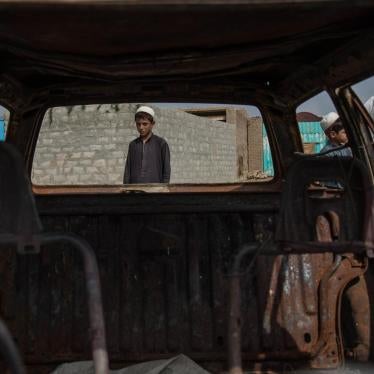On January 31, 2020, the administration of President Donald Trump announced the reversal of US prohibitions on landmine production and use. The decision nullifies years of steps by the US to align its policy and practice with the 1997 treaty banning antipersonnel landmines.
The decision was outlined in a three-page policy contained in a January 31, 2020 letter signed by Secretary of Defense Mark Esper.
Human Rights Watch chairs the International Campaign to Ban Landmines, 1997 Nobel Peace Laureate. Human Rights Watch has previously reviewed landmine policy decisions taken by President Barack Obama in 2014, President George W. Bush in 2004, and President Bill Clinton in 1998.
1. What is new in this landmine policy?
The new policy is a retrograde step. It reverses a 2014 policy decision by the Obama administration that unequivocally banned US production and acquisition of antipersonnel landmines, as well as their use outside of a future conflict on the Korean Peninsula.
The previous policy set the US goal of joining the 1997 Mine Ban Treaty, while the 2020 policy takes the US off its path toward joining the widely-respected treaty, which entered into force on March 1, 1999 and has been ratified by 164 nations.
The White House has made clear that antipersonnel landmines are the focus of the new policy, while the policy itself makes no distinction between antipersonnel and antivehicle mines. The Mine Ban Treaty prohibits antipersonnel mines, but not antivehicle mines or command-detonated (remote-controlled) mines.
The 2020 policy allows the US to develop, produce and use landmines as long as they are “non-persistent,” that is, equipped with self-destruct and self-deactivation features. The policy abandons the previous constraint on using antipersonnel mines only on the Korean peninsula and instead permits the US to use them anywhere in the world.
The policy lowers the authorization for use of landmines to the level of a four-star general acting as a regional commander. Previous policy—since 1996—required authorization at the Presidential level.
2. Why shouldn’t the US use antipersonnel landmines if it does so responsibly?
In a fact sheet entitled “Strategic Advantages of Landmines” issued with the 2020 policy announcement, the Department of Defense asserts that landmines are “a vital tool in conventional warfare” that provide “a necessary warfighting capability … while reducing the risk of unintended harm to non-combatants.”
However, just because the US can now use antipersonnel mines anywhere in the world does not mean it should do so. The political, humanitarian and other costs of doing so are too high.
Frequently Asked Questions (FAQs) prepared by the Department of Defense for the 2020 policy announcement assert that the US needs landmines now, because “the strategic environment has changed” since 2014 with “the return of Great Power Competition and a focus on near-peer competitors” or adversaries. Defense officials announcing the policy told media they could envision the US using landmines in a variety of theaters against a range of adversaries, such as Russia and China.
According to the FAQs, “Commanders will only approve the use of landmines when necessary for mission success in major contingencies or other exceptional circumstances.” They state that “the exceptional circumstances caveat … indicates the tool [landmines] will not be a default option.” The FAQs assert that “anti-personnel landmines will be used in situations where they are most appropriate, can be used within the confines of DoD’s policy and when alternatives are not viable.”
At a February 13, 2020 policy briefing for civil society representatives, Department of Defense officials said the US does not intend to use landmines around US bases in Iraq or Afghanistan. The officials acknowledged that landmines are indiscriminate yet argued that all weapons systems are indiscriminate to a certain extent.
3. When did the US last use antipersonnel landmines?
While the administration claims landmines are necessary for US forces, the US has not used antipersonnel mines since 1991. It has fought a wide range of conflicts, both high- and low-intensity in a variety of environments, and has demonstrated that it can employ strategies, tactics, and weaponry that avoid the use of antipersonnel mines.
During the Persian Gulf War in 1991, the US scattered 117,634 self-destructing/self-deactivating landmines, mostly from airplanes, in Kuwait and Iraq. A General Accounting Office (GAO) investigation found that U.S. commanders were reluctant to use the mines because of their impact on mobility, their potential for causing casualties to US or friendly forces, and other safety concerns.
In 2014, US officials acknowledged for the first time that US forces used one antipersonnel mine in Afghanistan in 2002.
The US military has refrained from using antipersonnel mines in part because of the stigma the Mine Ban Treaty has established against these weapons. All other NATO members are party to the treaty, as well as US allies Australia and Japan.
Department of Defense officials have said the US does not intend to pressure partners and allies to change their landmine policies, nor will the new US policy prevent it from conducting future operations in coalition with NATO and other partners.
The US does not maintain any minefields globally after removing its mines from around Guantanamo Naval Base in Cuba from 1996-1999. The landmines already emplaced in and near the Demilitarized Zone (DMZ) between North and South Korea are the responsibility of South Korean forces, not the US.
4. Why shouldn’t the US use landmines equipped with “safety” features?
The 2020 policy continues a previous 2004 policy prohibition on US use of “persistent” or “dumb” antipersonnel landmines, which lack self-destruct and self-deactivation features. It requires that “all activated landmines, regardless of whether they are remotely delivered or not,” are “designed and constructed to self-destruct in 30 days or less after emplacement and will possess a back-up self-deactivation feature.”
Such features are neither advanced nor sophisticated technology, and indeed are many decades old. Over the years, the US has used various terms to refer to “self-destruct” landmines, such as “smart” and “safe” mines,” though the weapons are neither. The 2020 policy now embraces the new term “non-persistent area denial systems.”
During the Ottawa Process to negotiate the treaty, the US tried but failed to secure a loophole in the draft treaty text to allow for self-destructing and self-deactivating mines. The Mine Ban Treaty makes no such distinction and comprehensively prohibits all types of victim-activated explosive devices, regardless of their predicted longevity, delivery method, or type of manufacture (improvised or factory-made).
Mines that are designed to self-destruct or deactivate are no better able to distinguish civilian from combatant. They still pose unacceptable risks for civilians. Civilians in “smart” minefields not only face the danger of triggering mines that have failed to self-destruct, but the danger of those mines randomly self-destructing at unknown times.
US mines can be scattered or remotely delivered by aircraft, artillery, or ground dispensers at a rate of thousands in a matter of minutes, over a wide area with little precision. Given the failure rate for self-destruction, many unexploded mines will remain on the ground with no outward indication of their “safety.” Because of the large quantities of these mines that are typically employed at one time, the danger to civilians could be greater than hand-laid non-self-destructing mines.
Self-destruction mechanisms are not 100 percent reliable and the clearance task for deminers is just as dangerous, time-consuming, and costly. Mines that have failed to self-destruct, but which may have self-deactivated, will have to be treated by deminers as live mines that may potentially explode.
Additionally, these mines, even after their “self-deactivation,” can provide material for improvised explosive devices (IEDs) that could be turned against US forces.
5. How many landmines does the United States stockpile?
Current US landmine stocks consist mostly of scatterable or remotely delivered mines (as opposed to hand-emplaced) that are deployed over wide areas by aircraft, artillery, or rockets, and are equipped with a self-destruct feature designed to detonate the mine after a pre-set period of time, as well as self-deactivating features. The active stockpile consists of the following types: Artillery Delivered Antipersonnel Mine (ADAM), Ground Emplaced Mine Scattering System (GEMSS), GATOR, Volcano (in M87 dispenser only), Pursuit Deterrent Munition (PDM), and Modular Pack Mine System (MOPMS).
The US did not provide any updated figures on the number of antipersonnel landmines held in stocks during the 2020 policy announcement, but previously, in 2014, the Pentagon disclosed that the US had an “active stockpile of just over 3 million anti-personnel mines in the inventory.” This was a significant reduction from the previous stockpile of approximately 10.4 million antipersonnel mines reported in 2002.
The existing US stockpile of antipersonnel mines is expected to expire—become unusable—by the early 2030s. The shelf-life of existing antipersonnel mines stockpiled by the US decreases over time through the chemical deterioration of battery components embedded inside mines. The 2014 policy precluded the US from extending or modifying the life of the batteries inside the existing stockpile. In 2014, a US official said the US would not extend the shelf-life of existing systems, for example, by replacing their batteries, which have a shelf-life of 36 years. A Department of Defense official said, “We anticipate that they will start to decline in their ability to be used … starting in about 10 years. And in 10 years after that, they'll be completely unusable.”
A Department of Defense fact sheet on “Landmine Safety and Technology” issued with the 2020 policy claims that “reliability of safety features of the landmines in the operational inventory is very high.”
6. Will the US re-start production of antipersonnel mines?
While it is not explicitly stated, the 2020 policy rolls back the 2014 policy pledge to “not produce or otherwise acquire any anti-personnel munitions that are not compliant with the Ottawa Convention in the future, including to replace such munitions as they expire in the coming years.” According to the DoD FAQs, the 2020 policy “encourages the Military Departments to explore acquiring landmines…that could further reduce the risk of unintended harm to non-combatants.”
Yet, US defense officials commenting on the new policy told media the U.S. has sufficient inventory of so-called smart landmines that there is no need to restart production immediately.
No antipersonnel mines or other victim-activated munitions are being funded in the FY2021 ammunition procurement budgets of the US Armed Services or Defense Department.
The last time the US produced antipersonnel mines was in 1997, when it manufactured 450,000 ADAM and 13,200 CBU-89/B Gator self-destructing/self-deactivating antipersonnel mines for $120 million. The last non-self-destruct antipersonnel mines were procured in 1990, when the US Army bought nearly 80,000 M16A1 antipersonnel mines for $1.9 million.
The new US policy returns the US to the list of a dozen countries worldwide that either actively produce antipersonnel landmines or reserve the right to do so: China, Cuba, India, Iran, Myanmar, North Korea, Pakistan, Russia, Singapore, South Korea, and Vietnam.
7. How does the new US policy affect the situation on the Korean Peninsula?
The 2014 policy allowed the US to use antipersonnel landmines on the Korean peninsula and the Trump administration policy does not change this.
Numerous retired military officers have questioned the perceived need to use antipersonnel landmines in South Korea, citing the overwhelming technological superiority of other weapons in the US-South Korean arsenal in comparison with North Korea’s. The Korea Peace Now! campaign condemned the US landmine policy change and called landmines “a threat to the peace and security of Koreans, Americans, and people all over the world.”
8. Has the US abandoned its search for alternatives to landmines?
For more than 20 years, the US has spent approximately 2 billion dollars on the development and production of weapons systems that could be considered alternatives to antipersonnel mines. The 2020 policy does not appear to abandon that search as it states that “the Military Departments should explore acquiring landmines and landmine alternatives that could further reduce the risk of unintended harm to noncombatants.” (Emphasis added)
The FY2020 procurement budgets allocates more funds to research and development of the “remote-detonated” Gator mine system, which the Department of Defense appears to have renamed as a “Deep Terrain Shaping Obstacle.”
Two previous alternatives programs included the XM-7 Spider Networked Munition and the IMS Scorpion. Both once had the potential for victim-activated features (thereby making them antipersonnel mines as defined by the Mine Ban Treaty), but they are now both strictly command-detonated by a human and therefore permissible under the treaty. FY2021 budget justification materials do not specify if the victim-activated feature of Spider, called the “battlefield over-ride” feature, will be reinserted as the system is modernized in coming years.
The 2020 policy states that the US may “acquire ‘on/off’ area denial systems that can be remotely activated to address an imminent or probable threat and de-activated when the threat subsides.” It’s unclear if victim-activated features will be required as part of the research and development program objectives.
9. Can the United States export antipersonnel mines again?
US law has prohibited all antipersonnel mine exports since October 23, 1992, through a comprehensive moratorium enacted at the initiative of Senator Patrick Leahy. According to the new policy, the Department of Defense “will not seek to transfer landmines except as provided for under U.S. law.”
The US is one of at least 34 countries that exported antipersonnel landmines in the past. It exported over 5.6 million antipersonnel mines to 38 countries between 1969 and 1992. Deminers in at least 28 mine-affected countries have reported the presence of US-manufactured antipersonnel mines, including non-self-destructing and self-destructing/self-deactivating types.
Due in part to the US export moratorium, there has been a de facto global ban on the transfer of antipersonnel mines in effect since the mid-1990s. Only a low level of illicit trade and of unacknowledged or denied trade has continued.
10. Does the new US policy affect its mine clearance contributions?
The leading role that the US has played in funding mine clearance programs around the world does not appear to be impacted by the 2020 policy decision. Acting Assistant Secretary of Defense for Strategy, Plan and Capabilities Vic Mercado pledged: “The United States will continue to lead in international humanitarian demining efforts that locate and remove landmines and explosive remnants of war that pose persistent threats to civilians living in current and former conflict areas around the world. The recession of the previous policy does not reduce this national commitment.”
11. How has the new landmine policy been received?
The Trump administration’s decision to reverse previous US limits on landmines has been widely condemned and criticized, which shows how the Mine Ban Treaty has helped to create a strong stigma against antipersonnel landmines.
In a statement, Mine Ban Treaty president Ambassador Osman Abufatima Adam Mohammad of Sudan said the new US policy “goes against its long-standing commitment to work towards the eradication of the suffering” caused by weapons.
Mine Ban Treaty States Parties such as Belgium, France, Germany, Netherlands, Norway, and Switzerland have expressed concern and disappointment over the new US policy, as has the European Union.
Several US senators have raised objections to the new US policy change, including Senator Leahy who said, “The example we set has global ramifications. This decision … reverses the gains we have made and weakens our global leadership.”
Members of the International Campaign to Ban Landmines are holding demonstrations and seeking meetings with US representatives in their countries to express their concerns over the new US landmine policy.
12. Why didn’t previous US presidents ban antipersonnel landmines?
The US participated in the Ottawa Process, which led to the creation of the Mine Ban Treaty, but did not sign when the treaty was opened for signature in December 1997. The Clinton administration set the goal of joining in 2006. However, in 2004 the Bush administration announced a new policy that rejected both the treaty and the goal of the US ever joining. In 2014, the Obama administration announced it was “diligently pursuing other solutions that would be compliant” with the 1997 Mine Ban Treaty and “that would ultimately allow us to accede” to it.
Two-thirds of the US Senate must approve US accession to the Mine Ban Treaty. Previously, in May 2010, 68 senators expressed their support for the Mine Ban Treaty in a 2010 sign-on letter to President Obama.








